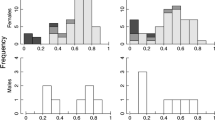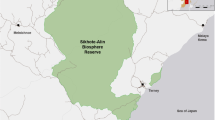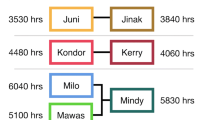Abstract
Numerous accounts of partial or complete breeding dispersal by adult females reported in the literature on microtines have been interpreted as maternal bequeathal. However, for most species, no causal relationship between a female's movements between successive litters and the settlement of her offspring in the natal range has been demonstrated. I tested predictions from the bequeathal hypothesis using data from an intensive study of Townsend's voles where genetical relationship had been determined by marking most pups in the maternal nest before weaning. After correcting statistically for temporal changes in the distance moved between successive litters I rejected the following predictions: (1) that females with one or several daughters of reproductive age should be more likely to disperse or disperse farther between successive births than females without such daughters; (2) that mothers should be more likely to bequeath their range to their daughters in spring when the latter would gain most from having ready access to a breeding range; (3) that daughters benefit from their mother abandoning the natal range through an increase in their probability of recruitment; and (4) that daughters actually use the home range vacated by their mother. I critically reassess the empirical studies quoted as evidence that breeding dispersal is a form of parental investment in microtines and other mammals. Most empirical studies cited in support of the bequeathal hypothesis often only contain anecdotal reports of movements by breeding females or do not mention it as one of its possible adaptive functions. Some studies contain evidence only consistent with the bequeathal hypothesis whereas others are incompatible with this explanation. Documented evidence of bequeathal comes exclusively from species which rely on a semi-permanent resource such as a midden, mound or burrow. I conclude that there is no indication from Townsend's voles or any other microtines that females abandon their breeding range to their female offspring as a form of parental investment.
Similar content being viewed by others
Author information
Authors and Affiliations
Additional information
Received: 27 February 1996 / Accepted after revision: 1 March 1997
Rights and permissions
About this article
Cite this article
Lambin, X. Home range shifts by breeding female Townsend's voles (Microtus townsendii ): a test of the territory bequeathal hypothesis. Behav Ecol Sociobiol 40, 363–372 (1997). https://doi.org/10.1007/s002650050352
Issue Date:
DOI: https://doi.org/10.1007/s002650050352




